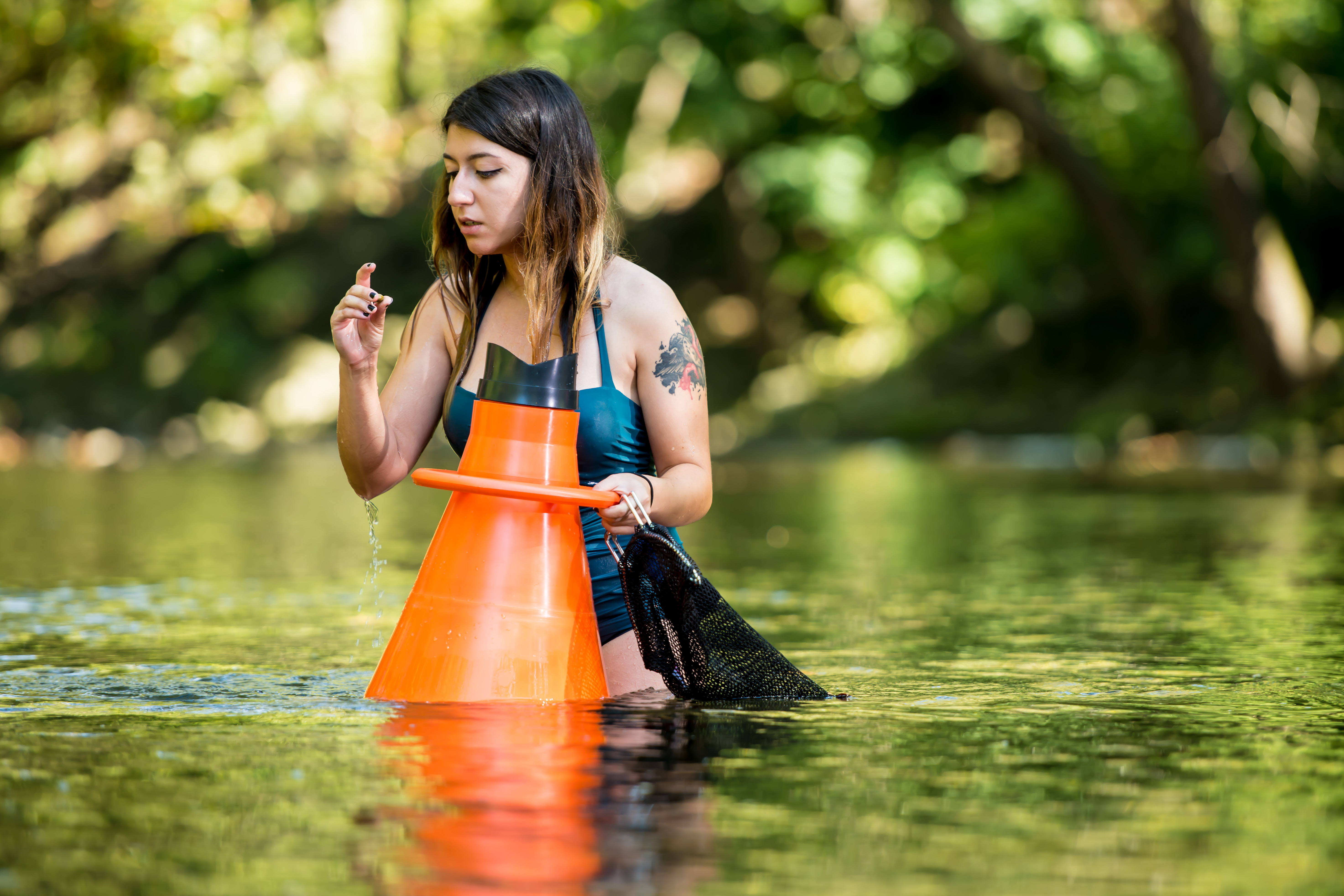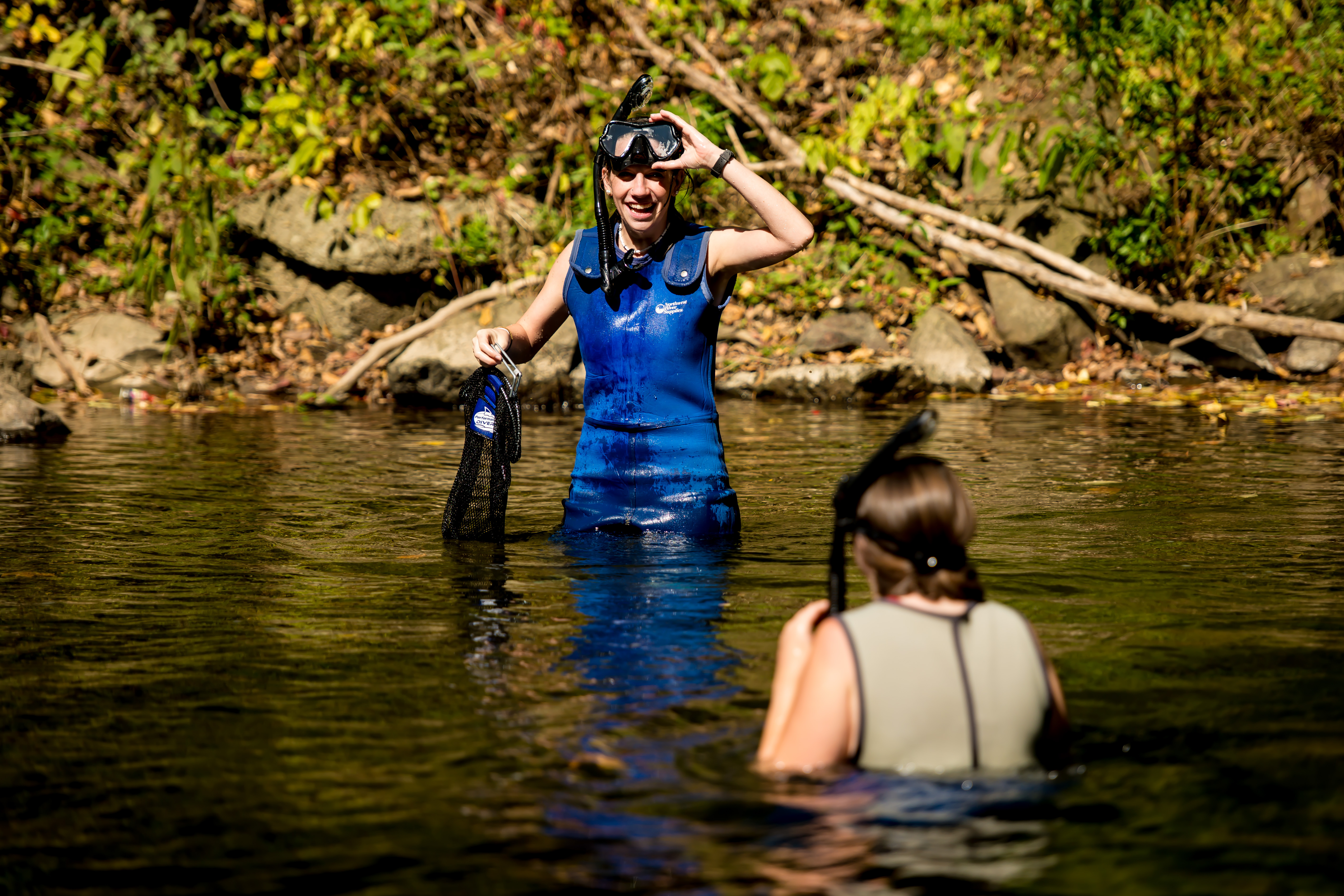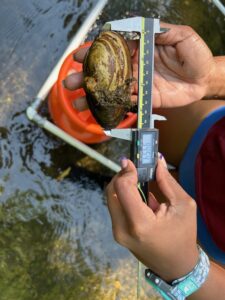The settlement agreement letter allotted $50,000 of the NRDA funds to mussel restoration projects. Honors Thesis research by Esra Demirhan ’18 and Eurnett Christopher ’25 builds upon our pre-dam removal monitoring efforts by evaluating the potential impacts of dam removal on freshwater mussels currently in the system and introducing native freshwater mussels to portions of the stream that have been restored.

Esra Demirhan ’18 uses a bucket with a glass bottom to search for bivalves along a transect in Bushkill Creek.
Freshwater mussels are often considered keystone species in freshwater ecosystems because of their ability to affect the organization of the community to a far greater degree than would be predicted considering their abundance. For example, mussels function as habitat generators by creating habitats for other organisms, stabilizing streambeds, and providing nutrients that stimulate primary production. Freshwater mussels also improve water quality through removal of suspended particles by filter-feeding. Yet, freshwater mussels are sensitive to environmental change, and they are recognized as one of the most imperiled groups of organisms. In North America, 10% of species went extinct in the last century, and only half of the remaining species are projected to survive the next century. Although the dramatic decline in mussels has involved a variety of threats, the single most important threat is habitat loss as a result of dam construction, channelization, siltation, and contaminants. Freshwater mussels also have a unique fish-dependent life cycle, which means that their distribution is restricted when fish movement is restricted by dams.

Emily Ramirez ’18 and Emily Lynch ’18 snorkeling in Bushkill Creek to scan sediments for freshwater mussels.
Pre-removal assessment included field surveys to quantify freshwater mussel abundance and distribution in Bushkill Creek and toxicity assays to assess the possible effects of heavy metals in released legacy sediments on survival and growth of mussels.
Esra’s results indicated that:
- freshwater mussels are absent in Bushkill Creek directly upstream and downstream of the dams but are present in Jacobsburg State Park ~5 km upstream of all dams and downstream of dam 1 in Delaware River at a catch per unit effort (CPUE) of 148.2.
- adverse effects to freshwater mussels downstream of dam 1 due to burial by fine-grained sediments or exposure to metals would be insignificant.
- reestablishment of the natural flow regime, improvements to water quality, and elimination of impediments to host fish migration will improve the likelihood of restoring freshwater mussel communities in lower Bushkill Creek.
Given that our pre-restoration assessment suggested that habitat conditions in Bushkill Creek are suitable for mussel reestablishment, we were excited to work with our restoration partners to plan the reintroduction. Now that dam removal has commenced, we have started working with Delaware River Basin Commission, PA DEP, and PA Fish & Boat to reintroduce two native freshwater mussels (i.e., Alewife floater and Eastern pondmussel) to newly restored areas of the Bushkill Creek. Approximately 2500 individuals were reintroduced by our team in summer 2024 and another 2500 individuals will be reintroduced in 2025.
In addition to continued ecological monitoring at our standard sites, we aim to establish clear goals and post-reintroduction monitoring protocols to assess freshwater mussel restoration success in Bushkill Creek. Our specific freshwater mussel restoration goals are:
- To establish a long-term, viable population of freshwater mussels in the lower Bushkill Creek (i.e., settlement of released individuals, post-release survival of individuals, and natural recruitment, Teixeira et al. 2007).
- To monitor water quality (e.g., dissolved oxygen, biotic indices of water quality, suspended sediment) and habitat conditions (e.g., sediment grain size) regularly at restored sites for continued assessment of site suitability for the reintroduced mussels.
- To share our findings and hold ongoing conversations with project stakeholders in an adaptive management framework (i.e., an iterative learning process in which new information either validates the effectiveness of management actions or guides modified management actions).

For her Honors Thesis, Eurnett Christopher ’25 will be responsible for establishing and initiating a monitoring protocol that will enable us to assess progress toward goal #1.

Jamie Bryan ’25 will be addressing goal #2 for her Honors Thesis in Environmental Science by creating a protocol to assess post-restoration habitat conditions for reintroduced mussels.
LAB FAM members who have contributed to this project: Esra Demirhan ’18, Donna Hanna ’22, Eurnett Christopher ’25, and Jamie Bryan ’25.


